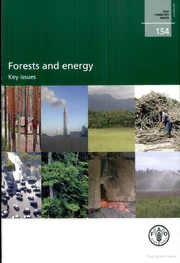
Forests and energy : key issues PDF
Preview Forests and energy : key issues
Forests and energy Key issues laterial Coverphotos,fromleft Top:FAO/FO-&079/C.Jekkel;WikimediaCommons/Gyre;FAO/FO-6077/A.Godbole;FAO/FO-S762/P.Durst Bottom:WikinwdiaCommons/BrokenSphere:FAO/FO-0071:FAO/FO-6849/M,France-Lanord;P.Aronsson Co(., y :odmaterial Forests and energy FAO FORESTRY PAPER Key issues 1 54 FOODANDAGRICULTUREORGANIZATIONOFTHEUNITEDNATIONS Rome,2008 Copyrightedmaterial Thedesignationsemployedandthepresentationofmaterialinthis informationproductdonotimplytheexpressionofanyofMnlonwhatsoever onthepartoftheFoodandAgncultLireOrganizationoftheUnitedNations (FAO)concerningthelegalordevelopmentstatusofanycountry,territory, dtyorareaorofitsauthorities,orconcerningthedelimitationofItsfrontiers orboundaries.Thementionofspecificcompaniesorproducts ofmanufacturers,whetherornotthesehavebeenpatented,doesnotimply thatthesehavebeenendorsedorrecommendedbyFAOinpreference toothersofasimilarnaturethatarenotmentioned. Theviewsexpressedinthisinformationproductarethoseoftheauthor(s) anddonotnecessarilyreflecttheviewsofFAO. ISBN978-92-5-105985-2 Allrightsreserved.Reproductionanddisseminationofmaterialintilis informationproductforeducationalorothernon-commercialpurposesare authorizedwithoutanypriorwrittenpermissionfromthecopyrightholders providedthesourceisfullyacknowledged.Reproductionofmaterialinthis informationproductforresaleorothercommercialpurposesisprohibited withoutwrittenpermissionofthecopyrightholders.Applicationsforsuch permissionshouldbeaddressedto: Chief ElectronicPublishingPolicyandSupportBranch CommunicationDivision FAO VialedelleTermediCaracalla,00153Rome,Italy orbye-mailto; COpyn9htOfao.org OFAO2008 Contents Acknowledgements vii Foreword ix Executivesummary xi 1. Introduction 1 2. Energysupplyanddemand:trendsandprospects 5 PpnpvA/sKIppnprnv/ g 113J Futureenergychoices-keyissues 18 Solidwoodfuels 21 Liquidbiofuels 22 4. Thecontributionofwoodenergytofutureenergydemand 27 Woodfuelsources 28 Emissionsandeconomicsofbiofuels ^2 5. Implicationsofincreased useofbioenergy 37 Poverty,employmentandprices 38 Landandenvironment 39 6. Policyoptionsandrecommendations 45 Glossary 49 References 53 This One SQ4E-RHL-4Y9B iv lables 1 woriatotalmarKeteaenergyconsumptionDyregionandTuei, 1990-2030 6 2Worldconsumptionofhydroelectricityandothermarketedrenewable energybyregion, 1990-2030 9 3 Globalincreaseinrenewableenergy 11 4 Peopleusingtraditionalbiomass 18 5Shareoffuelsintotalmerchandisebyregion 20 6WoodresiduesfromforestindustryoperationsinBrazil 29 Figures 1 TotalmarketedenergyconsumptionforOECDandnon-OECDcountries. 1990-2030 fi 2 Fuelsharesofworldtotalprimaryenergysupplyin2004 7 3Totalglobalmarketedenergyconsumptionbysourcein2004and projectecitorzujU 7 4MarketedrenewableenergyconsumptionforOECDandnon-OECD countries, isyu—zu^u 09 5 Percentageofmarketedrenewableenergyintotalenergyconsumption forOECDandnon-OECDcountriesin2004andprojectedfor2030 9 6Worldrenewableenergyconsumptionbyregionfor2002and projectedfor2030 11 7TotalprimaryenergysupplyfrombiofuelsforG8+5countries 12 8Percentageprimaryenergysupplyfrombioenergy 13 9Totalgrowingstock 14 10WoodfuelconsumptionforOECDandnon-OECDcountries1990. projectionsfor2010and2030 16 11 PercapitawoodfuelconsumptionforOECDandnon-OECDcountries 1990,projertionsfor2010and2030 17 12WoodremovalsinAfrica 17 13EuropeBrentSpotPriceFOB. 1987-2008 19 14Globalgreenhousegasemissionsin2000bysector 19 15Comparisonofgreenhousegasemissionsfrombiofuelsderivedfrom varioussources 34 16Competitivenessofbiofuelsbyfeedstock 34 Boxes 1 Bioenergyterminology 2 2 BiofuelsfortransportinBrazil 10 3 Impedimentstoaccuratewoodfuelinformation 15 4Forestproductprices 33 Copyri V 5 Energyefficiencyandbioenergyproduaion 35 6 Potentialbenefitsandnegativeeffectsofbioenergydevelopment 38 7 Foodpricesandbioenergy 40 8Scenariosforliquidbiofueldevelopment 42 1« Acknowledgements Thispublicationconsolidatesand synthesizestwomorecomprehensivestudies commissionedbyFAOin2007andpublishedasworkingpapers.TheyareForests andenergyindevehfmgcountriesbyIvanTomaselliandForestsandenergyin OECDcountriesbyWarrenMabeeandJackSaddler.Thesepaperscanbefoundat www.f.io.org/forcstry/cncrgy. Adraftversionoftheconsolidatedpaper,prepared byDouglasKneelandandAndreaPerils,wasdistributedattheFAOConference SpecialEvent:ForestsandEnergyinNovember2007.Thepresentedition,revised byJeremyBroadhcadandeditedbyMariaCasa,incorporatescommentsreceived from memberci^untrics. MiguelTrossero,SimmoneRose,SebastianHctschand GustavoBestalsocontributed. Oopyiiytiicainaieiial iz Foreword Forestsandenergyareatthecentreoftheglobaldebateonclimatechange.This publicationaddressessomeofthemostimportanttrendsinbothdiesesectorsto enlightenthedebate. Thepaperdraws upon two comprehensiye studies commissioned byFAO in2007:Foreftssndenergyindevelopingcountries(IvanTomaselli,Brazil)and ForestsandenergyinOECDcountries(WarrenMabccandJackSaddler,Canada). Theseworkingpapersareavailablein£nglishontheFAOWebsiteatwww.^. org/forcsty/energy. UpuntilICOvcarsagowhenpetroleumbecamewidelyavailable,woodwasthe mostimportantsourceofenergyforhumanbeings.Inmanyoftheworld'spoorest countries,woodremainstheprimarysourceotenergyforheatingandcooking.In thisstudy,welookintothefutureandseethatwoodisonceagainlikelytoemerge asaveryimportantsourceofenergyinallcountries. Bioenei^ from wood and t^cultural sources will regain its importance. Agriculturalandforestcropsplayaparticularroleinmodembioenergygeneration assourcesofliquidbiofuels.Whilefossilfuelsarelikelytoremainthedominant sourceofenergyforsometimetocome,along-termandgradualpartialconversion fromfossilfuelstosolidandliquidbiofuelsisanincreasinglylikelyscenariofor manycountriesinthecomingdecades.Willthesetrendshaveanimpactonforests? Willtheyresultinmoreorlessforestinthefuture? Thispublicationexploresthesequestionsandmoreasacontributiontoinformed policydiscussions. Itoutlinespotential opportunities and impactsinrelation to forestryindiecontemofgrowingglobal energy demand.Expectedchangesin globalenergysupplyandthepositionofrenewablesandforestenergywithinthis arediscussedinSection2.Aspectsofbioenergyproductionaresummarizedin Section3,andSection4reviewsthepossiblecontributionofforestenergytoglobal energy consun4>tion in the comingyears. Section5 examines the implications ofincreasedconsumptionofbioenergyonforests,andSection6outlinespolicy optionsandreoommendadonsinlightoftheopportunitiesandthreatstoforestry. WulfKiUmann Director ForestProductsandIndustriesDivision FAOForestryDepartment Oopyiiytiicainaieiial Executive summary Soaring energy consumption, increasing greenhouse gas emissions and concerns overenergyimportdependencearepromptingglobalchangesinthesourcesfrom whichenergyisexpectedtobederivedinthecomingyears.Energyconsumption isprojectedtoincreaseatthehighestratesindevelopingcountriesandparticularly inAsia.Fossilfuelsareexpectedtoaccountforthebulkoftheincreaseinenergy supply.Althoughpercapitalevelsofconsumptionwill remainbelowthoseinthe industrialized world, energy consumption in developing countries is expected to surpassthatofdevelopedcountriesby2010. Alternativeformsofenergyarereceivingconsiderableinterestasameanstoreduce fossilfuelconsumption and limitgreenhousegas emissions. Bioenergy,including wood energy,constitutes alargeproportion ofcurrent supplyfrom "renewable" sourcesofenergy.Inspiteoftherecentoilpriceincreases,itisunlikelythatmarkets alonewillsupportamajorreorientationtowardsrenewablesandfutureconsumption willthereforedependlargelyonpolicymeasures. Woodenergyhasbeenusedforthousandsofyearsforcookingandheating.In manyoftheworld'sdevelopingcountries,itremainstheprimary'sourceofenergy and in much ofAfrica total consumption ofwoodfuel is still increasing, largely asaresultofpopulationgrowth. Inotherdevelopingregionsconsumptionatthe nationallevelisgenerallyfallingasaresultofrisinglevelsofincomeandincreasing urbanization-twofactorswhichleadtoincreaseduseofmoreconvenientfuels. Inindustrializedcountriesand particularly countries with largewoodprocessing industries,woodenergyisusedforbothdomesticandindustrialpurposes-oftenin significantamounts. Wood energy produced with efficient technology is already competitive with fossilenergyinmanycountriesandcanoffersomeofthehighestlevelsofenergy and carbon efficiencyamongbioenergy feedstocks. Most notably, combined heat andpowerplantshaveconversionefficienciesofupto80percentandwoodpellet stoves havesimilarly high rates ofconversion. Itisexpectedthattechnologywill alsobeavailableinthemedium-termforcommerciallycompetitiveproductionof liquidbiofuelsfromcellulosicmaterialsincludingwood,althoughcostsassociated withpatentsandroyaltiesmayholdbackdevelopment.Liquidbiofuelsarecurrently producedmainlyfromfoodcropsandeconomicandcarbonefficienciesaremostly low.Thenotableexceptiontothisruleistheproductionofethanolfromsugarcane. InBrazil,bioethanolpricesarealreadybelowthoseforpetroleumbasedtransport fuels. Itisexpectedthatproductionofsecond-generationHquidbiofuelsmadefrom woodandothercellulosicfeedstockswillbesimilarlycompetitive,bothintermsof priceandcarbonemissions.Second-generationbiofuelproductionisalreadyunder wayindemonstrationplantsandcommerciallycompetitiveproductionisexpected
